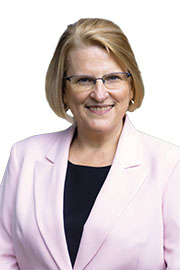- Apr/17/24 11:30:00 a.m.
What I would say to Elizabeth and the many individuals across Ontario who want to get their critical diagnostic and surgeries done faster is, first of all, why is your representative, why is your NDP member, opposed to innovation in the health care system? Why does your NDP member continue to rail against innovation in our hospital sector, whether that is expansion of surgical and diagnostic centres in our communities so that we, yes, can continue to decrease wait times for diagnostic and surgical interventions?
It is really unfortunate that we have a member who represents a party who is diametrically opposed, philosophically opposed, to innovation in our health care system. We need to encourage that innovation to make sure that your constituents like Elizabeth, organizations and individuals across Ontario get access to that—
Interjections.
And again, I will say an organization and an NDP—
- Hear!
- Rabble!
- Apr/17/24 11:30:00 a.m.
Speaker, this government has had six years to fix it, and it’s gotten worse, not better. That’s not innovation.
An Ontario Health Coalition report released yesterday uncovered the extent to which private clinics are using deceptive tactics to charge patients extra fees for OHIP-covered surgeries. In the case of cataract surgeries, they found clinics charging for extra eye measurements, tests, special lenses and unnecessary add-ons they say are better than OHIP-covered services. Seniors reported being charged for appointments, membership and administrative fees for primary care, as well as user fees.
Why is this minister ignoring the fact that seniors across Niagara and across Ontario are being ripped off by private, for-profit clinics?
- Hear!
- Rabble!
- Apr/17/24 11:30:00 a.m.
Thank you to the excellent member from Essex for the question. This MPP is doing a marvellous job advocating for seniors. I was honoured to join him along with the MPP for Windsor–Tecumseh to visit the new seniors active living centres in Kingsville and Amherstburg. They will each receive $50,000 in new funding for seniors in the community. This means places like the Kingsville Community Centre can expand their activities and allow even more seniors to participate. It was amazing to see the energy of the seniors in Essex. It makes such a difference in the lives of seniors when they come together.
Mr. Speaker, everywhere I go, I see seniors so happy because they’re active, socially connected and having fun.
- Hear!
- Rabble!
- Apr/17/24 11:30:00 a.m.
Speaker, my question is for the Minister for Seniors and Accessibility. Just a few weeks ago, I had the pleasure of hosting the minister in my riding of Essex, where we visited towns like Kingsville and Amherstburg and LaSalle. It was an opportunity to gather with seniors from communities and talk about the importance of staying active and staying connected.
Combatting social isolation is important for the health and well-being of our seniors. Our government must continue to invest in initiatives that help seniors stay fit and active and healthy in their own communities.
Speaker, can the minister share with the House what our government is doing to help seniors stay fit and active and healthy in Ontario?
We often hear the minister say that social isolation is enemy number one for seniors. They need access to programming that enables them to be engaged with their communities.
Speaker, can the minister share the importance of the seniors active living centres and how they are helping seniors in Ontario stay healthy and stay active and stay socially connected?
- Hear!
- Rabble!
- Apr/17/24 11:30:00 a.m.
My question is for the Premier. In Waterloo region, 770 acres of prime farmland in Wilmot township are at risk of being expropriated for an undisclosed industrial site. Waterloo’s regional official plan accommodated all anticipated growth until 2051 without significant farmland loss. This is very important for the people of the region of Waterloo. Yet a month ago, farmers in Wilmot were offered an insulting cash offer per acre and given seven days to accept an offer or face expropriation.
This government’s current legislation makes it possible for what is happening in Wilmot to happen anywhere in Ontario, with no transparency and no community consultation. We don’t need any more Vegas deals on Ontario land in this place.
My question to the Premier, why is this government undermining the farming sector and encouraging backroom deals with developers?
We lose 319 acres of farmland every single day. This entire process has been without transparency, without process, is outside the official plan and is indicative of where this government is going with regard to encouraging sprawl and decimating farmland.
I fully support this petition and will affix my signature.
- Hear!
- Rabble!
- Apr/17/24 11:30:00 a.m.
Just a very brief introduction: I noticed that we’ve been joined this afternoon by a variety of rabbis and leaders who are here as part of Education and Sharing Day, which marks the work of Rabbi Mendel Schneerson. I want to thank you for your leadership in Ontario. Welcome to Queen’s Park.
Deferred vote on the motion for second reading of the following bill:
Bill 185, An Act to amend various Acts / Projet de loi 185, Loi modifiant diverses lois.
- Hear!
- Rabble!

- Hear!
- Rabble!
- Apr/17/24 11:30:00 a.m.
Actually, we’re doing no such thing. I suggest the member speak to the regional municipality if she has specific questions.
What she references in the bill, of course, is an issue that came before this House when the Minister of Economic Development, Job Creation and Trade was trying to encourage the Volkswagen plant to operate or to establish itself in St. Thomas. The member will recall that a bill was brought forward into this House seeking to provide that community with the ability to provide incentives to help us land that. To the best of my recollection, that was passed unanimously by all members, including the member opposite. So if the member opposite and the party have a problem with what they unanimously passed, I would suggest that they chat with themselves about why it is that they would want to put at risk massive investments like the VW plant, like Stellantis and all of the other investments that we’re bringing that helped us create 700,000 jobs for the people of the province of Ontario.
- Hear!
- Rabble!
- Apr/17/24 11:30:00 a.m.
I would like to welcome back to the Legislature this afternoon folks from Ontario public health labs and OPSEU members Shannon Morris, Sara Fraser and Cody Williams. Welcome back to the Legislature.
These people have signed these petitions to ensure that we stop these closures in six communities and that the government invest in the infrastructure of Public Health Ontario labs.
I will sign my name to it and give it to page Aislyn, because I wholeheartedly support this.
- Hear!
- Rabble!
- Apr/17/24 11:30:00 a.m.
I’d like to welcome a few special guests this afternoon: first and foremost, Jeffrey Roode—welcome to the Legislature; as well as Jane Kovarikova, Shaida Maleki, Kimiya Zamani, David Steele and Shauna Buttivant and other members of my team who will be joining me very soon. Thank you so much for being here.
Mr. Parsa moved first reading of the following bill:
Bill 188, An Act to amend the Child, Youth and Family Services Act, 2017 and various other Acts / Projet de loi 188, Loi modifiant la Loi de 2017 sur les services à l’enfance, à la jeunesse et à la famille et diverses autres lois.
- Hear!
- Rabble!
- Apr/17/24 11:30:00 a.m.
Is it the pleasure of the House that the motion carry? Carried.
First reading agreed to.
Motion agreed to.
- Hear!
- Rabble!
- Apr/17/24 11:30:00 a.m.
I move that the following change be made to the membership of the following committee:
On the Standing Committee on Government Agencies, Mr. Smith (Scarborough Centre) replaces Mr. Bouma.
- Hear!
- Rabble!
- Apr/17/24 11:30:00 a.m.
I have friends and family in the gallery I would like to introduce. I’m joined by my son Thomas, my daughter Ella, as well as Ella’s friend Emma Corcoran and her mom, Roxanne Corcoran. Welcome to Queen’s Park.
Just as a summary of it, this is a real major concern. There are conversations about possibly closing six of the 11 public health labs in Ontario. The minister, obviously, today during question period, said that there’s no conversation about that at this moment. But it does make people nervous, especially in rural areas and northern Ontario. You would know the distances people have to travel.
The concerns people have are about medical testing as well as water testing. It’s what we swim in, what we drink, but also, just coming out of the pandemic, they do the testing for COVID; they do the testing for all medical procedures that come through. Having access or having the ability to get those samples to different labs and transportation, especially in the winter in northern Ontario, is a major concern for these members and what they’re doing.
As well, the consequences of closing down these labs if we hit another outbreak—you think of H1N1; you think of COVID-19; you think of measles rising recently. If we have a major outbreak and we’re unable to process the labs because they share work internally—because we’ll be cutting more than half of them if we close these down. That really is what their members are talking about and the concern they have and that access to lab testing especially in northern Ontario and rural areas.
I support this wholeheartedly. I’ll affix my signature and provide it to Duncan for the table.
- Hear!
- Rabble!
- Apr/17/24 11:30:00 a.m.
Your privatization is killing people. It’s disgusting.
This is asking that Ontario Works and ODSP rates be doubled because right now, it’s $733 a month for somebody on Ontario Works. There’s no way anybody can survive in the province of Ontario on $733 a month. The Ontario disability support payment plan is $1,300 a month; of that, $556 is for housing. There is nowhere in Ontario where you can rent a room for $556. There was a room advertised recently online for $800 for a bed in a kitchen.
These Ontario Works and ODSP rates are leaving people with disabilities in Ontario living in destitution. Many are choosing MAID, and that is one of the things that we are seeing in the news as well. So we’re calling upon the government to provide at least a doubling of ODSP and Ontario Works rates. It will save lives, and it will show the people in Ontario with disabilities that we have respect for them and that we want them to be able to live productive lives.
I fully support this petition, will affix my signature and pass it to page Shiara to take to the table.
- Hear!
- Rabble!
- Apr/17/24 3:10:00 p.m.
I’m proud once again to table a petition, “Vulnerable Persons Alert,” calling on the government to move Bill 74 through committee and back to the legislative floor to ensure that we have a system to bring people home safely when they’re vulnerable and they’ve gone missing in our communities.
This petition stems from the death of a young boy, Draven, who had autism, went missing and was very vulnerable, and unfortunately died and was not brought home safely. Also, a woman in Hamilton, Ms. Shirley Love, had dementia, was in her eighties, went missing—very cold weather elements—and was found four days later.
The alert system would ensure that the geographical area that the person went missing in was notified that there was a vulnerable person missing in their community and they would be able to keep an eye out for them.
As I’m sure you’re aware, Speaker, I wholeheartedly support this petition. I’m going to affix my name to it and give it to page Simon to give to the Clerk.
- Hear!
- Rabble!
- Apr/17/24 3:10:00 p.m.
I am very happy to rise for the third reading of the Improving Real Estate Management Act, 2024. Of course, today, I will be sharing my time with Amarjot Sandhu, my parliamentary assistant and the member for Brampton West.
If passed, this legislation would serve as the next step in our government’s plan to build a stronger Ontario by providing a more coordinated and strategic approach for managing our real estate portfolio. Opting for a more centralized approach to real estate management will allow Ontario to deliver critical priorities more cost-effectively, like building more housing, including affordable housing options, as well as long-term-care facilities, which Ontarians need and deserve. Centralizing and/or realigning the oversight of real estate is integral to our government’s strategy for increasing economic growth and saving taxpayer money.
Before I get into the details and potential benefits of the proposed legislation, I want to talk about how it fits into our government’s overarching plan for the future. Under Premier Ford’s leadership, our government is building a stronger and more prosperous Ontario. Across every corner of Ontario, we are making smart, targeted infrastructure investments that lay the foundation for economic growth and prosperity now and for future generations to come.
We understand that in order to keep pace with the demands of a rapidly growing population, building essential infrastructure is more critical than ever, especially when you consider Ontario is the fastest-growing region in North America. In 2023 alone, Ontario grew by more than 500,000 people and, by 2041, we anticipate Ontario’s population will grow by approximately 30%.
Infrastructure is the backbone of a strong and healthy economy. It is essential to the quality of life of Ontarians. It brings us together, connecting us to our families, friends, workplaces and schools every single day. When a new road, highway or transit line is built, we are helping hard-working residents get home to their families safely, conveniently and faster. When new high-speed Internet infrastructure is installed, we allow families to work, stay connected with their loved ones and educate their children in the comfort of their own communities and help online businesses grow and succeed. When we build hospitals and long-term-care homes, we ensure our most vulnerable have access to the care that they need. When we invest in new and affordable housing, we increase the housing supply and provide housing options for hard-working Ontarians and their families.
We have heard time and time again that municipalities need more funding options to meet the growing demand for infrastructure in their communities. Our government is listening, and we are taking action. For example, last month, we announced we are quadrupling the Housing-Enabling Water Systems Fund from $200 million to $825 million over the next three years. The initial intake of this program will help municipalities repair, rehabilitate and expand drinking water, waste water and stormwater infrastructure. Applications are being accepted until April 19. Our government has also introduced the new $1-billion Municipal Housing Infrastructure Program to support building core infrastructure projects such as road and water infrastructure to enable housing for growing and developing communities.
As I just mentioned, our government knows that investing in critical infrastructure is necessary for ensuring a world-class standard of living remains for generations to come. That is why we are giving municipalities the tools they need to build more homes faster to tackle the affordability crisis that is pricing too many people, especially young families and newcomers, out of the dream of home ownership.
As we navigate ongoing global economic uncertainty, our government’s responsible, targeted approach will allow us to build the critical infrastructure our communities need to thrive while saving taxpayer money. I’m incredibly proud to be a part of a government with an innovative strategy to build a stronger Ontario and a plan to get the job done fast.
We are investing over $190 billion over the next 10 years, including more than $26 billion this year alone, to get shovels in the ground to build priority infrastructure, such as highways, roads, hospitals, long-term-care facilities and schools that Ontarians depend on every day. These investments will also help us attract businesses and create good-paying jobs to the province. Our investments are laying the foundation for Ontario’s economic growth while supporting critical services that people need in order to succeed. Simply put, we are making life better for millions of people who call this beautiful province their home.
But it is important to remember that behind the bricks, mortar, steel and glass, and the enormous costs of these projects, the success of Ontario’s families, workers and businesses relies on our ability to maintain and build essential infrastructure quickly and efficiently.
Our government also understands that Ontario’s taxpayers cannot and should not be left to pick up the tab for the infrastructure the province needs. We must constantly find new ways to attract trusted Canadian institutional investors to help build essential infrastructure that would otherwise not be feasible, while ensuring we reduce the burden on taxpayers. That’s why we are creating an Ontario infrastructure bank called the Building Ontario Fund, a new arm’s-length, board-governed agency that will enable public sector pension plans and other trusted institutional investors to participate further in large-scale infrastructure projects across the province.
Under our proposal, our government will provide $3 billion to the Building Ontario Fund in initial funding to support its ability to invest in critical infrastructure projects here in Ontario. This initial investment will support critical projects, such as building new housing, including affordable housing options; new long-term-care homes; energy infrastructure; municipal and community infrastructure; and an expanded transportation network. The mandate of the Building Ontario Fund includes support for infrastructure projects for Indigenous communities that advance community and economic well-being. Our efforts will accelerate the development and completion of essential projects that address the most pressing needs of people across the province. Madam Speaker, I know the road ahead may not always be easy, but I also know that when faced with new challenges, Ontarians will come together to get the job done.
Across every corner of the province, we’re making incredible progress in our government’s plan to build critical infrastructure in our growing communities. Last December, I was pleased to join Infrastructure Ontario’s president and CEO Michael Lindsay for the release of its latest quarterly market update. With an estimated value of over $35 billion, this update lists 31 major infrastructure projects and pre-procurement and active procurement phases of development. The work behind this pipeline of projects is an indicator of the progress our government is making to get critical infrastructure projects built faster. It demonstrates our drive and ability to bring critical infrastructure projects to life by getting more shovels in the ground on the projects that Ontarians need, projects like:
—the West Park Healthcare Centre, which reached substantial completion last November. West Park will provide specialized rehabilitation and complex continuing care to help individuals manage difficult health challenges like lung disease, stroke or amputation arising from life-changing events or illnesses. The facility features a new six-storey hospital building providing in-patient, outpatient and outreach services;
—the site preparation under way to rebuild Ontario Place, which, once complete, will deliver over 50 acres of parks and public space woven through three anchored attractions: Therme’s water park and wellness facility, a revitalized concert venue and a brand-new science centre; and
—the construction under way at the 1Door4Care project at the Children’s Hospital of Eastern Ontario, which will become a single state-of-the-art, purpose-built site on the hospital’s main Smyth Road campus, bringing care closer to home for families. IO’s track record is one we should all be proud of, and their success has been critical in maintaining the confidence of taxpayers.
Since the inception of its public-private partnership program almost 20 years ago, IO has brought 87 projects to substantial completion. That is 87, Madam Speaker.
Our government understands that Ontario’s economic success depends on a healthy, competitive market, and our approach must adapt to meet the anticipated needs of the province’s growing population.
Our well-rounded strategy is attracting investments while addressing critical infrastructure needs, fostering economic growth and promoting responsible fiscal management.
We know that, despite our government’s historic infrastructure investments, more is needed to achieve our ambitious goals. To build strong communities we must find ways to innovate and efficiently manage our infrastructure to ensure it meets existing and growing demands so that Ontario remains the best place in the world to live, work and raise a family.
This includes implementing new ways to better manage and maintain real estate to help us keep pace with the growing demands on the province’s infrastructure. Many may not know this, but Ontario’s general real estate portfolio is one of Canada’s largest realty public sector portfolios and one of the largest in North America. This portfolio consists of approximately 43 million rentable square feet of space, with 77% being owned and 23% leased.
The realty portfolio consists of over 4,300 buildings and structures used daily for offices, courthouses, detention centres, etc. Despite being one of the province’s most valuable resources, there has never been a centralized approach to managing and overseeing decisions about real estate, which ultimately comes at a cost to the taxpayers.
The lack of a centralized approach to managing real estate has resulted in poor decision-making that lacks comprehensive and strategic direction aligned with government priorities and those of Ontarians, but our government will not repeat the mistakes of our predecessors.
By centralizing and realigning resources and expertise, we can avoid the duplication of efforts, reduce administrative costs and negotiate better deals for large-scale property transactions. Centralized real estate management enables government to optimize the use of its assets.
Centralization also reduces red tape, improves information flow and enhances collaboration to ensure projects can proceed without delay. This approach provides flexibility to adapt to changing economic conditions, allowing us to respond effectively to the evolving needs and challenges in the real estate landscape.
Centralizing the management of real estate will allow Ontario to operate more efficiently, make informed decisions that are aligned with our overarching goals, and mitigate risks while ensuring consistency and transparency in the process.
Since taking office in 2018, our government has embraced the opportunity to enhance the efficiency of managing Ontario’s real estate portfolio. We have proposed a framework to centralize specific real estate authorities and decision-making processes, which will improve the overall management of Ontario’s real estate portfolio. This is part of our promise to make life better for Ontarians by working harder, smarter, and more efficiently.
In partnership with Infrastructure Ontario, the Ministry of Infrastructure has developed a process to review and evaluate government surplus properties. We want to ensure that properties no longer needed by the government are repurposed to address the needs of Ontarians.
We want those properties to be used for government priorities like building more homes, including affordable housing and long-term-care homes. By doing so, we’re addressing a need, generating revenues, and reducing the burden on the taxpayer.
To ensure the government’s real estate assets are maintained and can continue to operate, our ministry has invested an additional $250 million over three years for capital repairs. And starting in 2023-24, we are investing $107 million over four years to address funding gaps for improving accessibility.
We are also continuing to optimize and centralize the provincial office real estate portfolio, which supports the workplaces of Ontario public service employees and associated organizations. We are supporting new ways of working in the office and designing modern workplaces to unlock and increase the value of government real estate assets. This includes projects in Toronto, Sudbury and Ottawa that will optimize government-owned office spaces. These projects will drive workplace transformation and reduce operational costs to improve the effectiveness of the Ontario public service and associated organizations. Our efforts have already seen a reduction in over 450,000 rentable square feet across the government’s real estate portfolio.
The government has recently revealed the new site for the head office of the Workplace Safety and Insurance Board, or WSIB, in London, Ontario. We anticipate this move will generate annual savings of $70 million for the WSIB, or a 40% reduction in overall costs compared to its existing head office in Toronto. Scheduled to open in 2025, the new office will initially employ at least 500 individuals and is expected to support the creation of a minimum of 2,000 jobs in the London area over the next five years. This will allow us to harness a skilled and top-tier workplace that can live and work within their local communities.
Last spring, the Legislature passed the Reducing Inefficiencies Act (Infrastructure Statute Law Amendments), 2023. Part of this legislation will empower the province to enhance real estate management. The other part of this legislation implements efficiency modifications to the class environmental assessment process. The passing of this legislation marked the first step in our government’s plan to establish a framework for centralizing real estate authority. The amendments for real estate management established an initial framework to remove and/or modify the real estate authority of specific organizations and provide the Minister of Infrastructure with authority over their real estate portfolios.
Only with the initial framework set out in the Reducing Inefficiencies Act can we propose some of the changes we are here for today, through Bill 151, the Improving Real Estate Management Act, 2024. The proposed amendments, if passed, would facilitate centralizing or realigning the real estate authority of 10 organizations and one proposed organization, allowing the government to act as one holistic organization to manage real estate while also meeting those organizations’ highly specialized service delivery needs, such as museums, science centres, convention centres and art galleries.
The proposed legislation before the House today suggests modification in two key areas. The province is proposing changes that would, if passed, create a framework to remove or modify four organizations and one proposed organization’s ability to deal with real estate, if prescribed. It would provide the Minister of Infrastructure with control of real estate property previously under the control of these organizations. The four organizations and one proposed organization impacted by these changes would include the Ontario Agency for Health Protection and Promotion—Public Health Ontario; Ontario Health; the Centennial Centre of Science and Technology—Ontario Science Centre; the Niagara Escarpment Commission; and the proposed Ontario Health atHome.
Secondly, this bill also proposes a tailored approach to modify the realty authority, in part, for the following six organizations: the McMichael Canadian Art Collection, Metropolitan Toronto Convention Centre Corp., Ottawa Convention Centre Corp., the Royal Ontario Museum, Science North, and the Algonquin Forestry Authority. Under the proposed approach, these organizations would be restricted from engaging in specific real estate activities. The organizations that fall under a tailored approach would maintain control over real estate but also need government or ministerial approval and must adhere to potential regulatory requirements to dispose of freehold interests in real property.
For instance, if passed, this legislation would prohibit the Royal Ontario Museum from buying or selling property without permission from the Lieutenant Governor in Council, also known as the LGIC. The museum would only be allowed to sell property if it followed specific rules set by the LGIC, so the museum could only sell its prime location at the intersection of Bloor Street and Queen’s Park if the LGIC approved the sale and the museum followed a prescribed set of rules.
Another example is the Algonquin Forestry Authority. They would need permission from the Minister of Natural Resources and Forestry to buy or sell any property.
Madam Speaker, the history of Ontario has shown us that a one-size-fits-all approach is not always the best approach when it comes to managing real estate. We can meet the varied needs of our province far more effectively by streamlining real estate authority to ensure our decisions contribute to our economic growth and prosperity and align with the well-being and high standard of living that Ontarians rightfully deserve. The proposed legislation before the House would create a more responsive, agile and accountable system to manage the complex nature of Ontario’s real estate governance.
Since 2020, the Ministry of Infrastructure has engaged in consultations with essential stakeholders as part of our government’s ongoing efforts to enhance the use of real estate. This collaborative effort includes 15 oversight ministries representing 39 organizations. Of these 39 organizations, 10 organizations and one proposed organization would be impacted by the proposed legislative amendments under Bill 151, the Improving Real Estate Management Act, 2024.
During these consultations, I was pleased to hear support to enhance real estate management, and that our plan was aligned with initiatives to enhance efficiency and effectiveness. This support of our plan is reiterated in the numerous third-party reviews on the benefits of a more centralized real estate model to optimize decision-making capacity.
In 2017, the annual report of the Auditor General detailed recommendations to ensure the effective and economical management and maintenance of properties in Ontario. The AG’s report recommended that the Ministry of Infrastructure thoroughly examine and implement enhancements in the management of government properties. It also highlighted the potential for increased efficiency in the operation of the ministry’s real estate portfolio through centralized authority and decision-making.
The 2018 Ernst and Young line-by-line review of government spending, entitled Managing Transformation: A Modernization Action Plan for Ontario, also verified the Ontario government’s commitment to restoring trust and accountability and maximizing the value of tax dollars. The report recommended that ministries manage their capital assets with the assistance of IO and emphasized the benefits of a centralized approach to real estate management and a more efficient asset management process. The benefits of a centralized approach could lead to reductions in overall government spending, a streamlined and efficient asset management life cycle, and improved policy alignment, enabling more efficient and cohesive government-wide decision-making.
The 2018 PricewaterhouseCoopers assessment of the general real estate portfolio operating model highlighted challenges in the way ministries and IO managed real estate, particularly for office space. The report emphasized that adopting an enterprise view for government real estate could enhance transparency, decision-making and reporting, while fostering integration with ministry programs.
The advantages of a more centralized model for managing real estate are clear. Rethinking or better managing the use of real estate can enhance accountability and align its use more tightly with our government’s overall priorities. We’ve seen first-hand how managing real estate in a decentralized manner can lead to underperforming assets that waste taxpayer dollars. Siloed approaches resulted in decisions that lacked a strategic and holistic vision.
Madam Speaker, the research and feedback on the ground reiterates the benefits of a centralized real estate model—the same model we are proposing, in part, through the proposed Bill 151, the Improving Real Estate Management Act, 2024. If passed, it will help increase efficiencies by allowing organizations to plan better and help maintain and manage real estate, allowing organizations to act in a clear, focused way that enables them to take an enterprise-wide approach when making decisions, while reducing costs by eliminating duplication of responsibilities and by providing clear guidelines, all while improving the quality of services that Ontario delivers.
Ontario has come so far after the challenges we’ve faced the past few years, and while we have made progress, we know that there is so much more to do. As we face challenging economic headwinds, we must continue creating the conditions for economic growth and prosperity while saving taxpayer dollars. And we must take more action to ensure people are connected to the high-quality services they expect and deserve no matter where they live.
The proposed legislation before the House today is not just about buildings and real estate; it’s about good government management. As we work to meet the demands of a rapidly growing population, Ontario must adopt a more centralized strategy for real estate management. A more centralized approach will allow us to align the allocation and use of properties to support Ontario’s broader goals and initiatives.
This proposed legislation represents the next steps in a clear and comprehensive framework our government has created to consolidate information and decision-making processes—a framework that prioritizes fiscal responsibility by identifying and eliminating redundancies, negotiating favourable terms and, overall, making more cost-effective decisions. This increased efficiency serves the interests of taxpayers and aligns with the complex and ever-changing regulatory landscape of governing public properties.
By consolidating real estate authority under the purview of the Ministry of Infrastructure, our government aims to enhance accountability for how we spend taxpayers’ dollars while safeguarding essential services that people rely on. Despite the unprecedented uncertainty facing the province today, our government continues to work shoulder to shoulder with Ontarians to find new ways to create the conditions to attract new investments and jobs across every corner of the province.
We are building a stronger and more resilient Ontario today and for future generations to come.
- Hear!
- Rabble!
- Apr/17/24 3:10:00 p.m.
Minister Surma, back to you.
- Hear!
- Rabble!
- Apr/17/24 3:10:00 p.m.
This petition, signed by around 300 of 7,000 signatures, is in support of stronger mental health services in the province of Ontario. It’s a petition that was inspired by the Roth family, who lost their daughter Kaitlyn to suicide.
Kaitlyn didn’t fit into the mental health services and supports that exist in the province of Ontario. She sought help. She wanted help. She wanted to get better, but at the end of the day, she was turned away and/or received insufficient or improper mental health supports.
This petition really calls on greater training, targeted funding, specifically asking the Associate Minister of Mental Health and Addictions to earmark funding for training to ensure that when people have enough courage to come forward, to request help in very difficult circumstances, that help is there for them.
It’s in honour of Kaitlyn Roth. It is my pleasure to affix my signature and call on the government to address the mental health crisis in Ontario.
Miss Surma moved third reading of the following bill:
Bill 151, An Act to amend various statutes regarding infrastructure / Projet de loi 151, Loi modifiant diverses lois relatives aux infrastructures.
- Hear!
- Rabble!
- Apr/17/24 3:10:00 p.m.
I have the honour to table a petition today that’s signed by many residents of the greater Sudbury area.
We know that air quality in our schools has a significant impact on our children, on their health, on their capacity to learn, on whether they’re present in school or not. But in Ontario, there are no standards for measuring or monitoring air quality and reporting on it. In our neighbouring province next door, Quebec, there are such standards, and so these petitioners are calling on the government of Ontario to require the Ministry of Education to take action to improve air quality in our schools and child care centres in Ontario by supporting and adopting the Improving Air Quality for Our Children Act.
I am very happy to add my signature to this petition and send it to the table with page Manha.
- Hear!
- Rabble!
- Apr/17/24 3:40:00 p.m.
I recognize the member for Brampton West.
- Hear!
- Rabble!















